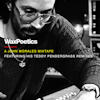Like so many other historic properties in modern-day Philly, the 212 N. Twelfth Street building is set to be razed, bought by an investing partnership and scheduled for demolition to make way for condos, retail, and office space. No, no, never… No, no, never… This is the love I lost, indeed. Tarsia may have sold Sigma in 2003 (to contractor Mario Santoro) but kept his long-vaulted, most valuable personal possessions: reel-to-reel tapes of varying size and DATs (many of which no longer have corresponding playback equipment) that were his musical life’s blood and work, to say nothing of Sigma’s heartbeat.
While Sigma’s most active users—Gamble and Huff and Thom Bell—took their now-Sony-owned tapes to Iron Mountain in Western Pennsylvania, Tarsia donated his collection of music, studio gear, and Sigma ephemera to Drexel University for storage and preservation. Santoro too unearthed hidden treasures in the basements of his property, also contacting Drexel U. for the sake of posterity.
For all of Sigma’s renowned history, this is where the story gets interesting. Instead of just letting Tarsia’s remaining tapes—many un-mastered, un-mixed, and un-produced—lay dormant, Toby Seay, a Drexel music-industry program professor, and Reservoir, an independent music publisher that holds the key to the long-gone Philly Groove Records label, have collaborated on newly produced versions of sixteen of that recording and publishing stable’s unfinished songs. That, according to those in the know, is just the beginning of the process.
Eight of Seay’s students turned once-lost, pre-disco cuts from soulful Sigma clients into fresh, raw R&B tunes with clean, vintage vibes. If everything goes as planned and Drexel’s MAD Dragon label and Reservoir release a joint album project later this year, these lesser-known Philly Groove greats will get their due next to that label’s legends such as the Delfonics.
For every famed cut—“La-La (Means I Love You),” “Didn’t I (Blow Your Mind This Time),” “Rubberband Man”— that became the Sound of Philadelphia, there are lesser-known cuts such as “Oh, So Lonely” or “I L.O.V.E. Y.O.U.” by lesser-known artists such as the later Terry Collins that no less make up the Philly Sound.
Drexel’s University Crossings building is where Seay and undergraduate students from his “Uncovering the Philly Groove” class have been working with raw vocal and instrumental tracks from a glut of that label’s catalog, completing dynamic soul songs that were started way before these twenty-or-so-year-old sophomores were born. Before you get to the classroom setting and its basement studios, you have to get through rooms filled with “Sigma stuff,” notes Seay with a laugh, sifting through boxes of Tarsia’s gold records—an Evelyn “Champagne” King single here, a Harold Melvin and the Blue Notes album (“featuring Theodore Pendergrass” reads the award) there.
Only then can you head into the building’s bowels to get to the temperature-controlled room where a dozen industrial shelves hold varying-sized tape cases with red-marker content listings. Massive reel-to-reels of Vince Montana, Benny Golson, Stevie Wonder, British prog-rockers Amon Düül, and power-pop group the A’s are some of the first things you see in this dark room. “These are the remnants of what was leftover after Tarsia sold Sigma,” says Seay, who took over the preservation of that Sigma/Drexel catalog in 2007. “This was all in storage—left for trash, really.” There are instrumental cuts and background vocal tapes from Bowie’s Young Americans, whose spins are clearly in view. There are boxes upon boxes of newer discoveries too. Seay explains that the Sigma tapes came in two gluts, 6,200 pieces between 2003 and 2005, then another five hundred pieces after the N. Twelfth Street property’s recent sale. “The realtor called and said, ‘Hey, the basement is full of tapes,’ so we grabbed them and those are right here,” says Seay, pointing to boxes of tapes whose contents has been noted but whose sounds have yet to be digitized.
Having history in his hands and the privilege of preservation was one thing, but moving the music beyond storage made Seay curious. “We don’t own the rights to what’s on them, the mechanicals, or publishing. We own the tapes. We can’t do anything with them unless we get permission, which, in and of itself, is a long trip.” Seay enlisted his fellow music business professors and students to contact publishers and license holders “to track it all back,” a laborious process considering that many of the copyright holders, let alone the artists, are dead or sold their rights long ago.
“Bobby Eli has been valuable, as he knows where the bodies are buried,” says Seay of a man who played guitar with Gamble and Huff’s house band MSFB along with composing, arranging, and producing countless Sigma records, songs, and sessions.
Eli cuts quite a figure himself, still. After having put together singers William Hart of the Delfonics, Ted Mills from Blue Magic, and Russell Thompkins Jr. of the Stylistics for a Legendary Tenors of Soul project, the guitarist opened his own studio in Philly’s suburbs, the Grooveyard, to record his own new discoveries. “Gotta keep moving, man,” he says. Eli recalls being pleased to hear from Seay and the people from Reservoir. “I love talking about the old days,” he says with a laugh. “It was like detective work, jogging the memory. I wish they kept me abreast of what they’re doing with the stuff, now, but…” he trails off. “I won’t lose sleep over it, but, still.”
“Philly’s music circles are small,” says Faith Newman. “We find each other.” Newman runs Reservoir Media, an artist services company that owns song catalogs, publishing rights, and licensing.
Around the same time that Seay was teaching students, Newman was tracking down Stan Watson, the owner of Philly Groove—a label he started in 1967 with songwriter/arranger Thom Bell—in Jupiter, Florida, to buy his catalog.
“Stan Watson was a genius of the Philadelphia sound, and a lost legend to boot,” says Jerry Blavat, a Rock and Roll Hall of Fame–awarded disc jockey from South Philly, the “Boss with the Hot Sauce,” and, legendarily, the “Geator with the Heater” who never stopped dancing or put down his turntable stylus. “Stan had amazing ears and good taste,” says Blavat, not surprised that Drexel or Reservoir wanted in on the Philly Groove history.
“Once we acquired it,” Newman says, “the next search was for actual assets—the tapes—which we knew numbered, like, five hundred songs.” While Newman found boxes of mastered and un-mastered reels in Florida, Eli, a friend of Reservoir’s throughout the years, led her to additional quarter-inch tapes of outtakes, bare vocals, instrumental sessions, and multitrack sessions—all in Drexel’s possession.
“It wasn’t until Reservoir called that we had our first bite of the publishing ball from our Philly Groove collection from Sigma, that we had something to work with beyond preservation,” says Seay.
“That’s when Toby and I brainstormed: what if these tracks did get finished and mastered,” says Newman of their hatched plan to involve Seay’s students in producing unfinished songs in accordance with how they hear things in 2015 and beyond.
But, funny enough, the students selected for the Philly Groove/Sigma project—which is due out later this year—didn’t envision a notably modern spin on the originals. “And they were free to do as they pleased,” recalls Seay. Instead, Seay’s eight sophomore producers cobbled together their unfinished symphonies—like Sound Experience’s “It’s a Funky Thing” with its bright brass, tribal rhythm, and fuzzy guitars; several heartbreaking Ben Aiken ballads—with warm vintage tones and dry vocal effects, just as producers would have done in 1968 or 1971. Liz Rosenberg, twenty, made rough vocalist Ernest Wright’s “I’ll Move the World for You” into a red-hot ensemble piece where the instruments bleed into each other rather than something cold and isolated.
Eli laughs when we talk about the Terry Collins’s songs that the students at Drexel found and made their own. “Hey, when I had him, he was great, gruff sounding, a heart of gold, but rough around the edges. I remember this one time, at Philly’s Thirtieth Street Train Station, I was coming up the steps and he was waiting for me at the top, thinking I owed him money. I hit the top step and he hit me square in the face and knocked me out.” That is one action that truly speaks louder than words.
“They recorded in one room, and that’s how I left the sound,” says twenty-year-old Brendan Monahan. He made his Terry Collins tune, “Actions Speak Louder Than Words,” into something clean (“these tracks were pristine to start with,” he notes) and thick with the sound of the bleed. “That’s how they—and we—maintained the feeling in the mix,” says Monahan. “That’s why these
records groove.”


